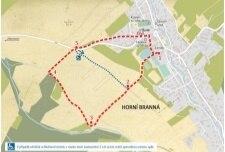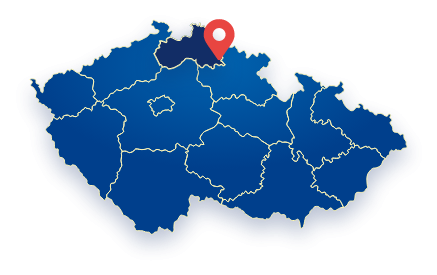Zastavení 2
Tabule – Ptáci v Podkrkonoší
Vždycky když jsem chodíval tady kolem křížku a pohlédl dolů
na Brannou, zatoužil jsem proletět se nad vesnicí jako pták.
Letěl bych přes branský kostel, Valteřice a kolem Sovince bych
dolétl až na Žalý, který leží směrem za touto tabulí.
Člověk pozoroval ptáky od pradávna. V kulturách po celém světě mají bohatou slovní zásobu vztahující se k popisu ptáků. Věda zabývající se studiem ptáků má název ornitologie. Ornitologové, stejně jako ostatní vědci, mají v oblibě vytvářet různé skupiny a podskupiny a do nich ptáky řadit. Tradiční ptačí jména jsou často založena na podrobné znalosti jejich vzhledu a chování.
Největším ptákem v tomto kraji je čáp černý z druhu ptáků brodivých. Z dravců je zde nejvíce zastoupené káně lesní.
Ale je zde možné spatřit i krahujce, jestřába či poštolku.
Mimochodem, asi jste si všimli, že Horní Brannou a Valteřicemi protéká potok Sovinka. Ten dostal své jméno v dobách, kdy tady všude byl hustý les. V noci se
z něho ozývalo strašidelné houkání sov, kterých tu bylo mnoho.
V současné době zde ze sov žijí puštík obecný nebo sýc rousný. Dříve se zde vyskytovala i sova ušatá, kalous i sova bahenní.
V lesích a na polích žijí ptáci hrabaví. Z nich zde najdeme tetřívka, bažanta, koroptev či křepelku. Ptáci hrabaví mají tu smůlu, že jejich maso je od dávných dob bráno za delikatesu, takže je loví nejen lidé, ale i predátoři z řad zvířat.
Z druhu krátkokřídlých je zde nejvíce zastoupen chřástal polní, z dlouhokřídlých pak čejka chocholatá a sluka lesní. Hojně se zde vyskytují holub hřivnáč a hrdlička zahradní, což jsou ptáci měkkozobí. Podle hlasu snad každé dítě pozná kukačku.
Z ptáků šplhavých zde můžeme narazit hlavně na strakapouda velkého nebo malého, vzácněji pak i na datla černého.
Nejvíce zastpouenou skupinou ptáků jsou zde pěvci.
Nejhojnější výskyt zde má skřivan polní, vlaštovka obecná, jiřička obecná, linduška lesní, linduška luční, konipas horský, střízlík obecný, pěvuška modrá, červenka obecná, rehek domácí, kos černý, drozd zpěvný, pěnice černohlavá, budníček menší, králíček obecný, sýkory, pěnkava obecná a další.
Station 2
Tafel – Vögel im Riesengebirgsvorland
Immer wenn ich hier am Kreuz vorbeiging und auf Branná hinunterschaute, sehnte ich mich danach, wie ein Vogel über dem Dorf dahinzufliegen. Ich würde über die Kirche von Branná fliegen, weiter über Valtěrice, den Berg Sovinec bis zum Berg Žaly, der in der Richtung hinter dieser Tafel liegt.
Der Mensch hat seit jeher Vögel beobachtet. Kulturen auf der ganzen Welt verfügen über einen umfangreichen Wortschatz, der sich auf die Beschreibung von Vögeln bezieht. Die Wissenschaft, die sich mit dem Studium der Vögel beschäftigt, heißt Ornithologie. Ornithologen haben – wie alle anderen Wissenschaftler auch – eine Vorliebe dafür, Gruppen und Untergruppen zu bilden und diesen die Vögel zuzuordnen. Die traditionellen Vogelnamen gründen oft auf detaillierten Kenntnissen ihres Aussehens und Verhaltens.
Der größte Vogel in diesem Gebiet ist der schwarze Storch aus der Ordnung der Schreitvögel. Von den Raubvögeln ist hier am meisten der Mäusebussard vertreten. Aber auch Sperber, Habichte und Turmfalken sind hier zu sehen.
Nebenbei bemerkt: wahrscheinlich haben sie bemerkt, dass durch Horní Branná und Valtěřice der Bach Sovinka (deutsch: Eulenbach) fließt. Dieser bekam seinen Namen zu der Zeit, als hier noch überall dichte Wälder wuchsen. In der Nacht tönte daraus der unheimliche Ruf der Eulen hervor, von denen es hier unzählige gab. Von den Eulen gibt es hier heute noch den Waldkauz oder den Raufußkauz. Früher kamen hier auch die Waldohreule oder die Sumpfohreule vor.
In den Wäldern und auf den Feldern leben Hühnervögel. Davon sind hier Auerhühner, Fasane, Rebhühner oder Wachteln zu finden. Hühnervögel haben das Pech, dass ihr Fleisch von jeher als Delikatesse gilt, sodass sie nicht nur von Menschen, sondern auch von Raubtieren gejagt werden.
Von der Ordnung der Kranichvögel ist hier am meisten der Wachtelkönig vertreten, von den Regenpfeiferartigen der Kiebitz und die Waldschnepfe. In großer Zahl kommen hier Ringel- und Türkentauben vor. Nach seiner Stimme erkennt wohl jedes Kind den Kuckuck.
Von den Spechtvögeln können wir hier hauptsächlich den Buntspecht, den Kleinspecht und – etwas seltener – auch den Schwarzspecht antreffen.
Die am meisten vertretende Ordnung sind die Singvögel. Am häufigsten kommen vor: die Feldlerche, die Rauchschwalbe, die Mehlschwalbe, der Baumpieper, der Wiesenpieper, die Gebirgsstelze, der Zaunkönig, die Heckenbraunelle, das Rotkehlchen, der Hausrotschwanz, die Amsel, die Singdrossel, die Mönchsgrasmücke, der Zilpzalp, das Wintergoldhähnchen, die Meise, der Buchfink u.a.m.
Stand 2
Board – Birds in the region of Podkrkonoší
Every time when I was walking here past the cross and looked down at Branná I felt a great desire to fly above the village like a bird. I would fly above the church in Branná, above Valteřice, and past Sovinec I would fly up to Žalý, which lies somewhere far behind this board.
People have always watched birds. Cultures all around the world dispose of rich word-stocks relating to bird descriptions. The science studying birds is called ornithology. Ornithologists, like all other scientists, are keen to create various groups and subgroups and classify birds according to them. Traditional bird names are often based on detailed knowledge of their look and behaviour.
The biggest bird of this region is black stork belonging to the order called Ciconiiformes. The most common representative of the birds of prey here is the common buzzard (Buteo buteo). However, it is also possible to see here sparrowhawks, goshawks or kestrels.
By the way, you have probably noticed that the stream of Sovinka flows through Horní Branná and Valteřice. It got its name in times when there was a deep forest all around here. At night owls, which the forest was full of, filled it with their scary hooting.
At present, the owls living here are e.g. tawny owl or boreal owl. In the past there also used to be long-eared owl, Asio, and short-eared owl.
In the forests and fields we can find birds belonging to the Galliformes. In this region we can find the black grouse, pheasant, partridge or quail. However, the representatives of this order are unlucky as their meat has always been considered a delicacy so they are prey hunted by both people and animal predators.
The representative of the order of the Gruiformes that is most frequent here is the corn crake, from the order of Charadriiformes there are the northern lapwing and the Eurasian woodcock. The common wood pigeon and the collared dove, the representatives of the order of the Columbiformes, can be seen here as well. When hearing its voice, even a child can recognize a cuckoo. Among the representative of the order of Piciformes that are present here, we can mention especially the great spotted woodpecker and the lesser spotted woodpecker, more rarely also the black woodpecker can be spotted here.
The most widely represented bird order here are the Passeriformes.
Most widely-spread species here are the Eurasian skylark, barn swallow, house martin, tree pipit, meadow pipit, grey wagtail, Eurasian wren, dunnock, robin redbreast, Black redstart, blackbird, song thrush, blackcap, chiffchaff, goldcrest, tits, chaffinch, and others.
Przystanek 2
Tablica – Ptaki Podkrkonoší
Zawsze, kiedy chodziłem tędy koło krzyża i spoglądałem w dół na Branną, pragnąłem przelecieć nad wsią jak ptak. Leciałbym przez kościół i Valteřice i koło Sovinca doleciałbym aż na szczyt Žalý, wznoszący się za tą tablicą.
Człowiek od pradawnych czasów obserwował ptaki. Na całym świecie w różnych kulturach ludzie mają bogate słownictwo dotyczące ptaków. Nauka zajmująca się badaniem ptaków to ornitologia. Ornitolodzy, podobnie jak inni naukowcy, lubią tworzyć różne grupy i podgrupy i zgodnie z nimi klasyfikować ptaki. Tradycyjne nazwy ptaków wynikają często ze szczegółowej wiedzy na temat ich wyglądu i zachowań.
Największym ptakiem w tym regionie jest bocian czarny z rzędu ptaków brodzących. Spośród ptaków drapieżnych najpopularniejszy jest myszołów, można też jednak spotkać krogulca, jastrzębia czy pustułkę.
Tak na marginesie – pewno zauważyliście, że przez Horní Branną i Valteřice przepływa potok Sovinka. Swoją nazwę otrzymał w czasach, kiedy wszędzie dookoła rósł gęsty las. W nocy słychać było z niego przerażające pohukiwania sów, których było tu wiele.
Dziś z sów napotkać tu możemy puszczyka i włochatkę. Wcześniej występowała tu też uszatka zwyczajna i błotna.
W lasach i na polach żyją ptaki grzebiące. Z nich wymieńmy cietrzewia, bażanta, kuropatwę czy przepiórkę. Ptaki grzebiące nie mają lekko. Ich mięso od dawna uważane jest za smakołyk, polują na nie nie tylko ludzie, ale też zwierzęta drapieżne.
Spośród żurawiowych najbardziej pospolity jest tu derkacz zwyczajny, spośród siewkowatych zaś czajka zwyczajna i słonka. Obficie występuje gołąb grzywacz i sierpówka, należące do ptaków gołębiowych. Chyba każde dziecko rozpozna też po głosie kukułkę.
Z ptaków dzięciołowych natrafić możemy przede wszystkim na dzięcioła dużego i małego, rzadziej też dzięcioła czarnego
Najliczniejszą u nas grupą ptaków są ptaki śpiewające.
Spośród nich najczęściej występuje skowronek, jaskółka dymówka, jaskółka oknówka, świergotek drzewny i łąkowy, pliszka górska, strzyżyk zwyczajny, płochacz pokrzywnica, rudzik, kopciuszek, kos, drozd śpiewak, kapturka, pierwiosnek, mysikrólik, sikory, zięba i inne.





